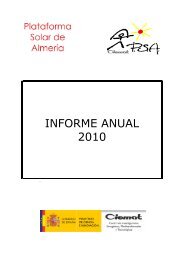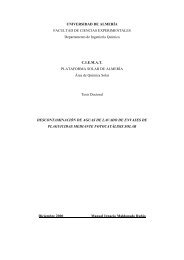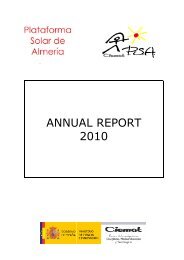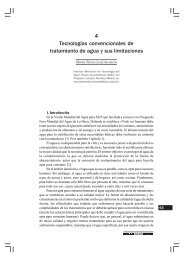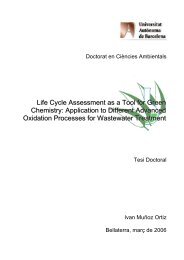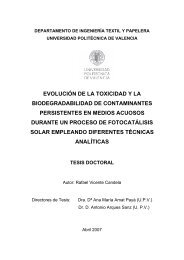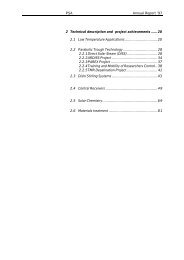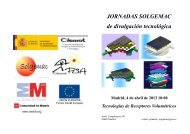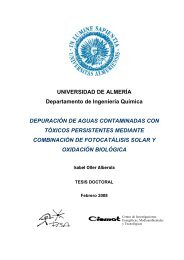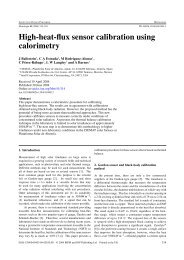Annual Report 2006 - Plataforma Solar de AlmerÃa
Annual Report 2006 - Plataforma Solar de AlmerÃa
Annual Report 2006 - Plataforma Solar de AlmerÃa
Create successful ePaper yourself
Turn your PDF publications into a flip-book with our unique Google optimized e-Paper software.
ENVIRONMENTAL APPLICATIONS OF SOLAR ENERGY<br />
Duration: March 2002 – February <strong>2006</strong><br />
Motivation: Seawater <strong>de</strong>salination is one of the possible solutions to the<br />
severe water shortage problem that our planet is going to un<strong>de</strong>rgo during the<br />
first half of this century, a problem which is not exclusively in <strong>de</strong>veloping<br />
countries, as the appearance of persistent seasonal droughts are more and<br />
more frequent in some regions of <strong>de</strong>veloped countries.<br />
In spite of all of the advances of the last few <strong>de</strong>ca<strong>de</strong>s, seawater <strong>de</strong>salination<br />
technologies continue being intensive fossil-fuel consumers. In the present<br />
world framework, with growing instability of oil market prices and environmental<br />
<strong>de</strong>mands <strong>de</strong>rived fro compliance with the Kyoto Protocol, sustainable<br />
<strong>de</strong>salination must unavoidably be arrived at through improved efficiency<br />
of the technologies involved as well as the use of renewable energy resources.<br />
The AQUASOL project faces both options by using solar thermal energy as the<br />
renewable energy resource and contributes to increasing the thermal efficiency<br />
of the multi-effect distillation process. The environmental impact of the<br />
<strong>de</strong>salination process has also been reduced by recovering the salt contained in<br />
the brine.<br />
Purposes: The main goal of the AQUASOL project is the <strong>de</strong>velopment of a hybrid<br />
solar/gas seawater <strong>de</strong>salination technology based on multi-effect distillation<br />
(MED) which also meets the principles of energy efficiency, low cost and<br />
zero discharge.<br />
Objectives met in <strong>2006</strong>: The implementation of the different subsystems was<br />
completed during this period and their testing un<strong>de</strong>r real weather conditions<br />
was begun at the PSA facilities (MED Plant, heat pump and solar field) and the<br />
Greek saltern Hellenic Saltworks on the Island of Lesbos (<strong>Solar</strong> Dryer).<br />
The AQUASOL system has three different operating mo<strong>de</strong>s <strong>de</strong>pending on<br />
the origin of the thermal energy:<br />
• <strong>Solar</strong>-only mo<strong>de</strong>: the thermal energy supply to the first effect of the<br />
distillation plant comes exclusively from the solar collector field.<br />
• Fossil-only mo<strong>de</strong>: the double-effect heat pump supplies all of the energy<br />
required by the distillation plant<br />
• Hybrid mo<strong>de</strong>: the energy supply comes from both the heat pump and<br />
the solar field. Two different operating philosophies are consi<strong>de</strong>red: in<br />
the first the heat pump works continuously 24 hours a day supplying<br />
the minimum 30%, while in the second it starts up and stops, <strong>de</strong>pending<br />
on the solar resource availability.<br />
The operating and maintenance experience with the AQUASOL system has<br />
been shown to be highly reliable, with no important problems being recor<strong>de</strong>d<br />
during testing. The solar collector field has <strong>de</strong>monstrated an average daily<br />
efficiency (ratio between the thermal power <strong>de</strong>livered to the storage tanks<br />
and the global solar radiation inci<strong>de</strong>nt on the tilted surface of the collectors)<br />
of 48%. The plant performance factor (kg distillate produced per 2316 kJ<br />
thermal energy supplied to the system) in solar-only mo<strong>de</strong> is over 10.<br />
As a result of evaluation of the new absorption heat puma after the first<br />
tests, it was <strong>de</strong>ci<strong>de</strong>d to change the initial configuration of parallel flow to series<br />
flow, to improve the controllability of the equipment, especially during<br />
transients. After this modification, the unit showed excellent behavior, increasing<br />
the plant performance factor from 10 to over 20, which is a 100%<br />
increase in thermal process efficiency. In hybrid mo<strong>de</strong>, it should be mentioned<br />
that the absorption pump showed strong thermal inertia, mainly due to the<br />
fact that the maximum power <strong>de</strong>livered by the steam boiler is much more<br />
than required by the pump un<strong>de</strong>r stationary conditions. The best results were<br />
89



